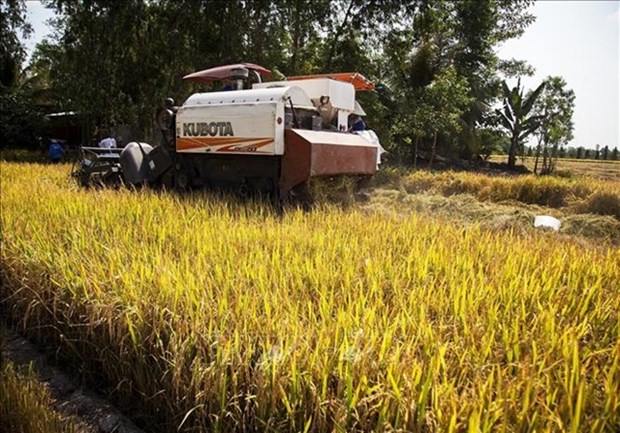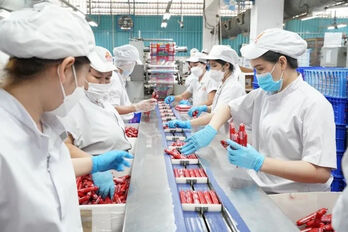 Harvesting rice in the Mekong Delta province of Long An (Photo: VNA)
Harvesting rice in the Mekong Delta province of Long An (Photo: VNA)
Ta Thu Trang from the Institute for Policy and Strategy under the Ministry of Agriculture and Rural Development (MARD) said the country's agriculture sector had made significant progress in recent decades.
From 2010-20, Vietnam agriculture maintained a 2.83% annual growth rate on average, accounting for as much as 12% of the entire world's rice export.
Foreign investors have played an important role in the country's success to modernise its agriculture sector by introducing advanced technologies and creating thousands of jobs. However, there was still a lot of untapped potential in the sector.
Trang said during 2009-21, foreign investors only registered under 2,000 projects, just 5.7% of all projects in Vietnam with 17.64 billion USD worth of investment, or 4.3% of total investment.
"For an agriculture-based country such as Vietnam, the amount of foreign investment in the sector has been, at best, modest," she said.
The vast majority of said projects were from Asian countries, which mostly went to the area surrounding the capital city of Hanoi and the Mekong Delta thanks to relatively developed infrastructure already in place, she added.
In addition, there have been incidents in which foreign projects deliberately took advantage of the numerous free trade agreements signed by Vietnam to fabricate made-in-Vietnam products without investing in production within the country.
Dr Nguyen Anh Phong, head of MARD's information centre said in order to bring foreign investment in Vietnam's agriculture sector to 34 billion USD by the end of 2030, there was an urgent need to increase collaboration with large corporations across all industries in the sectors, especially in technology transfer.
However, it's important to focus on bolstering the domestic supply chains for key input, which Vietnam traditionally has been overly reliant on import, such as seeds, livestock feed, fertiliser, vaccine, medicine, pesticides, management software, slaughter lines and processing technology.
In an earlier development, MARD put forward a proposal for a number of policy changes to planning larger production centres that employed state-of-the-art equipment, to filter investors to select the most suitable technology and a mechanism to purchase raw material from farmers on a large scale directly.
Cao Tri Cong, deputy-chairman of the Association of Vietnam Timber and Forest Product, said it was high time the country invested in supporting industries to wood manufacturing. The fast-growing industry has been largely reliant on raw material import for decades with little to no meaningful policies that favour domestic suppliers.
Dr Nguyen Anh Tuan, deputy-chairman of Vietnam's Association of Foreign Invested Enterprises, said, however, the proposal must go deeper into finer details such as which industry must be made a priority and where it will be located.
Tuan said to double the amount of foreign investment in the sector from now until the end of 2030, Vietnam must have a detailed action plan and it must be implemented as soon as possible.
He urged MARD to pay more attention to medicinal herbs, a rising star in recent years among the sector's industries, with still a lot of room to grow and value to be added.
"MARD should consult with local communities to help them form ideas as to which plant and animal they can best produce. In addition, there is a need to build a national database to help with advertising and promotion to attract foreign investment," he said.
He added MARD should make a shortlist of international corporations that are considered suitable and desirable for the central government.
Duong Danh Cong from Agrotrade Vietnam under MARD called for a task force specialising in finding foreign agriculture investors.
"The task force must not only have a deep understanding of the needs of potential investors but also the abilities of local communities to find the right investor for the right region," he said./.
VNA
 Vietnam on track to rank among world’s 30 largest economies
Vietnam on track to rank among world’s 30 largest economies

 Harvesting rice in the Mekong Delta province of Long An (Photo: VNA)
Harvesting rice in the Mekong Delta province of Long An (Photo: VNA)
